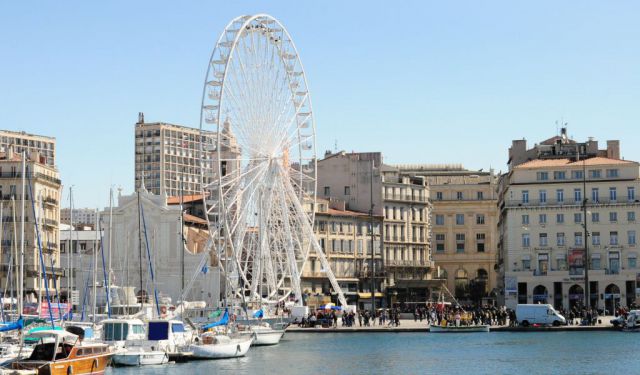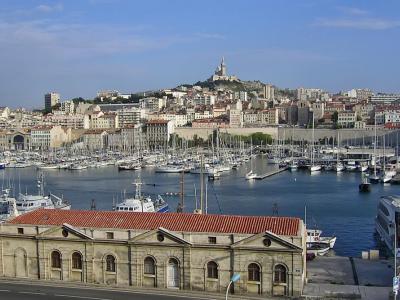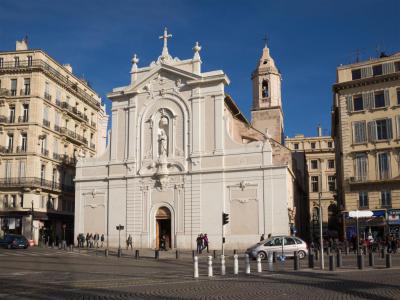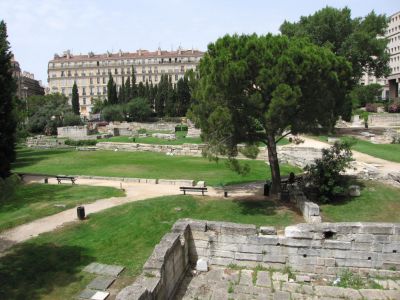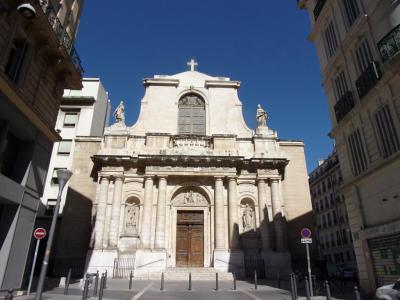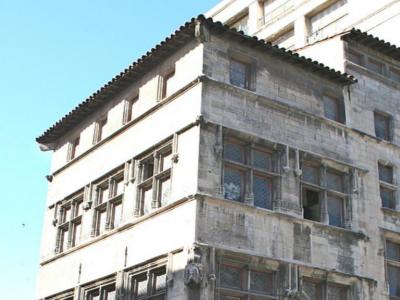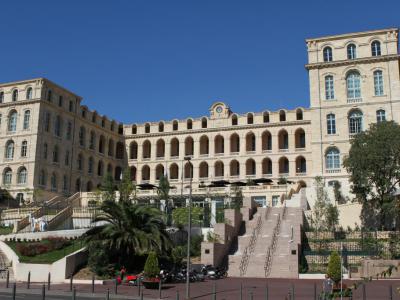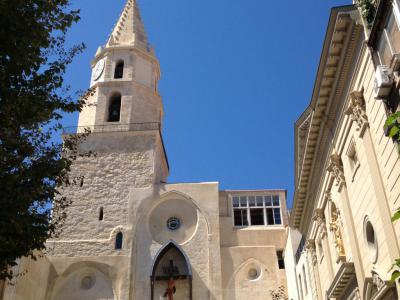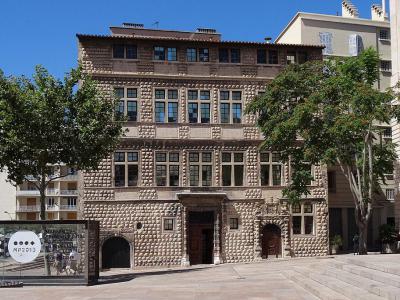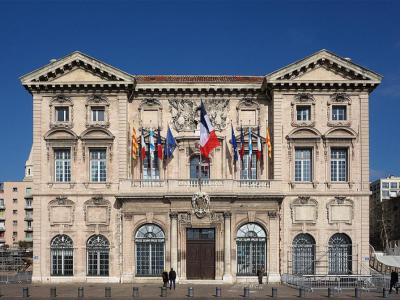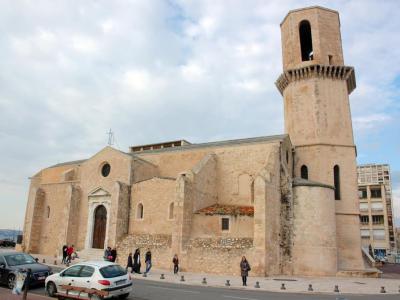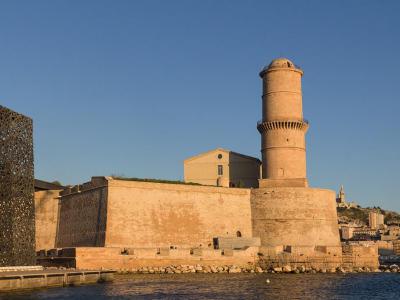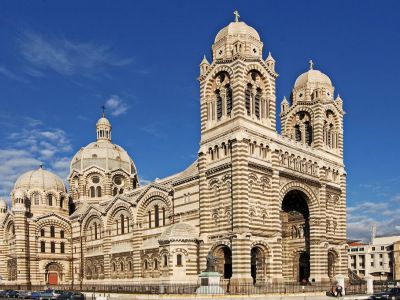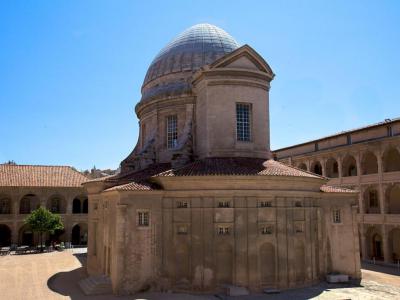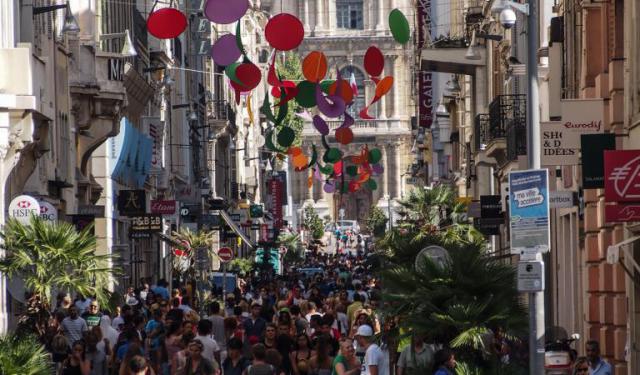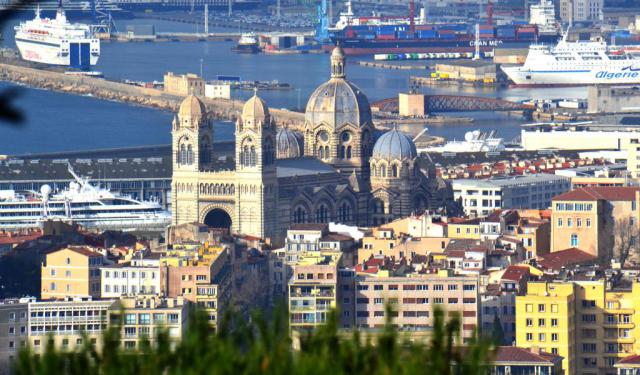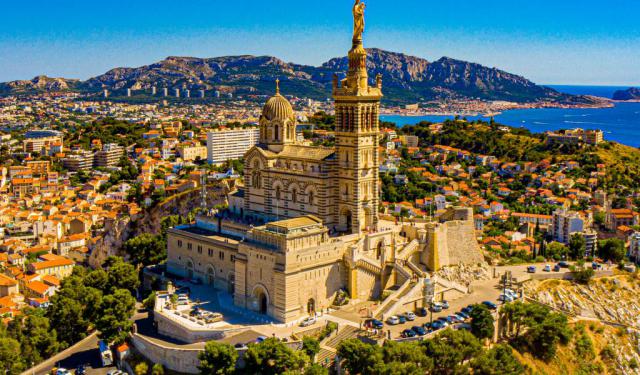Audio Guide: Marseille's Old Town (Self Guided), Marseille
Marseille’s Old Town, known as Le Panier—which means “the Basket” in French—is the historic heart of the city and one of the oldest urban settlements in France. Its name likely derives from an old inn called “The Inn of the Basket,” which existed in the 17th century, though the district itself traces its origins back more than 2,600 years.
Rising above the Old Port, this hillside quarter preserves the site of the original Greek settlement founded around 600 BCE. The Greeks built their fortified acropolis here, shaping the narrow, irregular lanes that still define the area’s layout today. Layers of Roman, medieval, and early modern history remain visible in its stone walls, vaulted passages, and tiny squares.
Through the Middle Ages, the Old Town became a lively center of trade and craftsmanship. Merchants, fishermen, and artisans filled its crowded streets, while small chapels and community workshops marked every corner. Its dense, maze-like character reflects centuries of urban growth and a blend of Mediterranean influences. Despite periods of plague, piracy, and hardship, the neighborhood maintained a strong identity rooted in local life and cultural exchange.
The Old Town’s darkest chapter came in 1943, when German occupation forces evacuated residents and demolished large parts of the quarter. Yet several historic structures survived, and postwar reconstruction carefully balanced preservation with renewal.
Visitors can explore the Cathedral of Saint Mary Major, a Romanesque-Byzantine masterpiece near the waterfront, and admire the peaceful Church of Saint Ferreol of the Augustinians by the Old Port. The Old Charity, a 17th-century almshouse with a graceful Baroque chapel, now houses museums and exhibitions. Nearby, the Garden of Ruins displays ancient Greek and Roman remains, offering a vivid glimpse into the city’s earliest beginnings.
Today, Old Town remains a key focus of Marseille’s urban heritage initiatives, forming part of the city’s protected historic district. Ongoing conservation projects continue to restore façades, repurpose centuries-old buildings, and sustain the neighborhood’s role as both a residential area and a cultural destination linking Marseille’s ancient past to its modern Mediterranean identity.
Rising above the Old Port, this hillside quarter preserves the site of the original Greek settlement founded around 600 BCE. The Greeks built their fortified acropolis here, shaping the narrow, irregular lanes that still define the area’s layout today. Layers of Roman, medieval, and early modern history remain visible in its stone walls, vaulted passages, and tiny squares.
Through the Middle Ages, the Old Town became a lively center of trade and craftsmanship. Merchants, fishermen, and artisans filled its crowded streets, while small chapels and community workshops marked every corner. Its dense, maze-like character reflects centuries of urban growth and a blend of Mediterranean influences. Despite periods of plague, piracy, and hardship, the neighborhood maintained a strong identity rooted in local life and cultural exchange.
The Old Town’s darkest chapter came in 1943, when German occupation forces evacuated residents and demolished large parts of the quarter. Yet several historic structures survived, and postwar reconstruction carefully balanced preservation with renewal.
Visitors can explore the Cathedral of Saint Mary Major, a Romanesque-Byzantine masterpiece near the waterfront, and admire the peaceful Church of Saint Ferreol of the Augustinians by the Old Port. The Old Charity, a 17th-century almshouse with a graceful Baroque chapel, now houses museums and exhibitions. Nearby, the Garden of Ruins displays ancient Greek and Roman remains, offering a vivid glimpse into the city’s earliest beginnings.
Today, Old Town remains a key focus of Marseille’s urban heritage initiatives, forming part of the city’s protected historic district. Ongoing conservation projects continue to restore façades, repurpose centuries-old buildings, and sustain the neighborhood’s role as both a residential area and a cultural destination linking Marseille’s ancient past to its modern Mediterranean identity.
How it works: Download the app "GPSmyCity: Walks in 1K+ Cities" from Apple App Store or Google Play Store to your mobile phone or tablet. The app turns your mobile device into a personal tour guide and its built-in GPS navigation functions guide you from one tour stop to next. The app works offline, so no data plan is needed when traveling abroad.
Marseille's Old Town Map
Guide Name: Marseille's Old Town
Guide Location: France » Marseille (See other walking tours in Marseille)
Guide Type: Self-guided Walking Tour (Sightseeing)
# of Attractions: 13
Tour Duration: 2 Hour(s)
Travel Distance: 2.9 Km or 1.8 Miles
Author: leticia
Sight(s) Featured in This Guide:
Guide Location: France » Marseille (See other walking tours in Marseille)
Guide Type: Self-guided Walking Tour (Sightseeing)
# of Attractions: 13
Tour Duration: 2 Hour(s)
Travel Distance: 2.9 Km or 1.8 Miles
Author: leticia
Sight(s) Featured in This Guide:
- Vieux-Port (Old Port)
- Église of Saint-Ferréol les Augustins (Church of Saint Ferreol)
- Jardin des Vestiges (Garden of Ruins)
- Église Saint-Cannat (Saint Cannat Church)
- Hôtel de Cabre (Cabre Hotel)
- InterContinental Marseille Hotel Dieu
- Church of Our Lady of the Accoules
- Maison Diamantée (Diamond House)
- Hotel de Ville (City Hall)
- St. Laurent Church
- Fort Saint-Jean
- Cathédrale de la Major (Marseille Cathedral)
- La Vieille Charité (Vieille Charité Center)
1) Vieux-Port (Old Port) (must see)
The Old Port is the city’s historic heart and one of the most evocative harbours in Europe, being a centre of maritime life for over 2,600 years. The site was first used as a trading post by the Phoenicians, long before the Greek settlers from Phocaea officially established it in 600 BCE as the port of Massalia, making it the birthplace of the city itself.
Through the centuries, the Old Port became a hub of Mediterranean commerce and naval activity. Kings Louis XII and Louis XIII expanded the shipyards in the 15th and 16th centuries, while King Louis XIV added the imposing Fort Saint John and Fort Saint Nicholas to defend the entrance of the harbour. The port reached its commercial peak in the 19th century, when up to 18,000 merchant vessels docked here annually, rivaling the activity of major ports such as Liverpool and Le Havre. However, with the arrival of large steamships that required deeper waters, Marseille shifted much of its industrial trade to the Port of La Joliette, located farther north.
The Old Port suffered immense damage during World War II, when German forces, assisted by French police, demolished much of the area to block access to Allied troops. Postwar reconstruction reshaped the district, and by the late 20th century, major urban renewal projects restored the port’s vitality. Architect Norman Foster’s redesign, featuring the The Shade Pavilion, a mirrored canopy that reflects the harbour below, marked a new era of pedestrian-friendly space and modern elegance.
Today, the Port serves as a marina for yachts, ferries, and fishing boats, as well as the site of a daily fish market that preserves centuries-old local tradition. Lined with cafés, restaurants, and open-air terraces, it remains a favourite gathering place for both locals and visitors.
Through the centuries, the Old Port became a hub of Mediterranean commerce and naval activity. Kings Louis XII and Louis XIII expanded the shipyards in the 15th and 16th centuries, while King Louis XIV added the imposing Fort Saint John and Fort Saint Nicholas to defend the entrance of the harbour. The port reached its commercial peak in the 19th century, when up to 18,000 merchant vessels docked here annually, rivaling the activity of major ports such as Liverpool and Le Havre. However, with the arrival of large steamships that required deeper waters, Marseille shifted much of its industrial trade to the Port of La Joliette, located farther north.
The Old Port suffered immense damage during World War II, when German forces, assisted by French police, demolished much of the area to block access to Allied troops. Postwar reconstruction reshaped the district, and by the late 20th century, major urban renewal projects restored the port’s vitality. Architect Norman Foster’s redesign, featuring the The Shade Pavilion, a mirrored canopy that reflects the harbour below, marked a new era of pedestrian-friendly space and modern elegance.
Today, the Port serves as a marina for yachts, ferries, and fishing boats, as well as the site of a daily fish market that preserves centuries-old local tradition. Lined with cafés, restaurants, and open-air terraces, it remains a favourite gathering place for both locals and visitors.
2) Église of Saint-Ferréol les Augustins (Church of Saint Ferreol)
The Church of Saint Ferréol is a Roman Catholic church with a rich and layered history. Originally owned by the Knights Templar, it was granted to a community of Augustinian hermits in 1369. In 1447, they began constructing a new church, which was dedicated in 1542, although the vaulted ceiling was not completed until 1588.
During the Old Regime, the church hosted professional guild ceremonies. The ship-porters’ guild maintained altars dedicated to Saint Peter and Saint Paul as early as 1390. One of the most significant events associated with the site occurred on October 28, 1533, when Pope Clement VII presided over the marriage of noblewoman Catherine de’ Medici and the future Henry II of France, Duke of Orléans. However, the ceremony did not take place inside the Church of Saint Ferréol itself, which was still under construction, but rather in a temporary chapel within the nearby Palace of the Augustinian Priory.
Architecturally, the Church of Saint Ferréol holds many artistic and historical treasures. The high altar, along with the side altars of the Augustinians and ship-porters, was designed by Dominique Fossaty. Inside, visitors can see the Mazenod family tomb from 1564 and the Montolieu family tomb from 1695, as well as the relics of Saint Louis of Toulouse.
The church also contains important works of art. Three paintings by Michel Serre depict Saint Margaret, The Virgin and Child Appearing to Saint Peter, and Saint Paul. Sculptures include a bust of Saint Ferreolus of Vienne and a statue of Saint Augustine by Raymond Servian. A more recent addition, the Holy Family by Yves Le Pape, continues the church’s artistic legacy.
Adding to its grandeur is the neogothic pipe organ, designed by Augustin Zieger in 1844, which remains a centerpiece of this enduring landmark.
During the Old Regime, the church hosted professional guild ceremonies. The ship-porters’ guild maintained altars dedicated to Saint Peter and Saint Paul as early as 1390. One of the most significant events associated with the site occurred on October 28, 1533, when Pope Clement VII presided over the marriage of noblewoman Catherine de’ Medici and the future Henry II of France, Duke of Orléans. However, the ceremony did not take place inside the Church of Saint Ferréol itself, which was still under construction, but rather in a temporary chapel within the nearby Palace of the Augustinian Priory.
Architecturally, the Church of Saint Ferréol holds many artistic and historical treasures. The high altar, along with the side altars of the Augustinians and ship-porters, was designed by Dominique Fossaty. Inside, visitors can see the Mazenod family tomb from 1564 and the Montolieu family tomb from 1695, as well as the relics of Saint Louis of Toulouse.
The church also contains important works of art. Three paintings by Michel Serre depict Saint Margaret, The Virgin and Child Appearing to Saint Peter, and Saint Paul. Sculptures include a bust of Saint Ferreolus of Vienne and a statue of Saint Augustine by Raymond Servian. A more recent addition, the Holy Family by Yves Le Pape, continues the church’s artistic legacy.
Adding to its grandeur is the neogothic pipe organ, designed by Augustin Zieger in 1844, which remains a centerpiece of this enduring landmark.
3) Jardin des Vestiges (Garden of Ruins)
Marseille seems to have been here forever—and in the Garden of Ruins, you can see traces of a port that dates back more than 2,000 years. Foundation stones still bear the masons’ marks of ancient Greek and Roman builders, a tangible link to the city’s earliest days.
Imagine the sound of wooden ships creaking against stone quays and the bustle of merchants along the waterfront. The remains of this ancient port were unearthed during excavations for the nearby Bourse Shopping Center, revealing layers of Marseille’s maritime past. Some of the structures and artifacts on display date as far back as the 6th century BCE.
The garden was designed and developed by Joël-Louis Martin, a renowned landscape architect, and is managed by the Museum of Marseille. Visitors can clearly see the outlines of wharves, docks, and storage areas that once formed the heart of one of the Mediterranean’s busiest trading hubs.
The Garden of Ruins is accessible with a ticket purchased from the Museum of Marseille. Informational panels in English, French, and Italian guide visitors through this remarkable archaeological window into the city’s ancient seafaring history.
Imagine the sound of wooden ships creaking against stone quays and the bustle of merchants along the waterfront. The remains of this ancient port were unearthed during excavations for the nearby Bourse Shopping Center, revealing layers of Marseille’s maritime past. Some of the structures and artifacts on display date as far back as the 6th century BCE.
The garden was designed and developed by Joël-Louis Martin, a renowned landscape architect, and is managed by the Museum of Marseille. Visitors can clearly see the outlines of wharves, docks, and storage areas that once formed the heart of one of the Mediterranean’s busiest trading hubs.
The Garden of Ruins is accessible with a ticket purchased from the Museum of Marseille. Informational panels in English, French, and Italian guide visitors through this remarkable archaeological window into the city’s ancient seafaring history.
4) Église Saint-Cannat (Saint Cannat Church)
The Saint-Cannat Church stands as one of Marseille’s most elegant examples of Baroque religious architecture and an enduring symbol of faith. Dedicated to Saint Cannat, a 5th-century bishop of Marseille and revered saint, the church has served as a place of worship for centuries. Construction began on December 31, 1526, and after nearly a century of devotion and craftsmanship, the church was consecrated on May 18, 1619.
Inside, the church reveals a rich artistic heritage. Visitors can admire two beautiful paintings by Michel Serre—The Virgin and Child and The Purification of the Virgin—both masterful examples of Provençal Baroque art. Another highlight is The Baptism of Christ by Pierre Parrocel, a work celebrated for its balance and serene color palette. A sculpture of Saint Thérèse of Lisieux, created by François Carli, stands among other devotional artworks.
Music lovers will be drawn to the church’s magnificent pipe organ, built in 1747 by renowned organ maker Jean-Esprit Isnard. The instrument’s elegant design and superb acoustics continue to fill the nave with harmonious sound during concerts and religious ceremonies. Recognized for its historical and cultural significance, Saint-Cannat Church was officially listed as a Historic Monument on November 2, 1926.
Inside, the church reveals a rich artistic heritage. Visitors can admire two beautiful paintings by Michel Serre—The Virgin and Child and The Purification of the Virgin—both masterful examples of Provençal Baroque art. Another highlight is The Baptism of Christ by Pierre Parrocel, a work celebrated for its balance and serene color palette. A sculpture of Saint Thérèse of Lisieux, created by François Carli, stands among other devotional artworks.
Music lovers will be drawn to the church’s magnificent pipe organ, built in 1747 by renowned organ maker Jean-Esprit Isnard. The instrument’s elegant design and superb acoustics continue to fill the nave with harmonious sound during concerts and religious ceremonies. Recognized for its historical and cultural significance, Saint-Cannat Church was officially listed as a Historic Monument on November 2, 1926.
5) Hôtel de Cabre (Cabre Hotel)
The Cabre Hotel, constructed around 1535, is generally acknowledged as the oldest house in Marseille still standing and in use today, commissioned by Louis de Cabre, a prominent merchant and Second Consul of Marseille in 1544. Its facade immediately captures attention: a combination of Gothic vertical emphasis and the delicate proportions of Renaissance design, a rare merger in a cityscape otherwise dominated by later style periods.
The house has witnessed centuries of dramatic change. During the French Revolution, the floral coats-of-arms and stylized lilies symbols that once adorned the façade were destroyed by anti-royalist forces. In 1943, when German occupation forces carried out massive demolition along the north bank of the Old Port, the Cabre Hotel was among the very few historic buildings spared—remarkably, given the scale of destruction in the neighbourhood.
Visitors can still spot the original sculptural details that celebrate its founder and family: effigies of Louis de Cabre and his wife stand framed on the façade, alongside cherubs and a statue of Saint James—a deliberate tribute to Louis’s father, Jacques de Cabre. A curious footnote: in the 1950s, the house faced demolition during a street-widening project, but it was instead moved 15 metres and rotated 90° on hydraulic rails so it could be preserved in place.
Today, while the interior of the Cabre Hotel is not open to the public, its exterior remains a vital living link to Marseille’s past—a quiet yet expressive testament to the city’s enduring spirit.
The house has witnessed centuries of dramatic change. During the French Revolution, the floral coats-of-arms and stylized lilies symbols that once adorned the façade were destroyed by anti-royalist forces. In 1943, when German occupation forces carried out massive demolition along the north bank of the Old Port, the Cabre Hotel was among the very few historic buildings spared—remarkably, given the scale of destruction in the neighbourhood.
Visitors can still spot the original sculptural details that celebrate its founder and family: effigies of Louis de Cabre and his wife stand framed on the façade, alongside cherubs and a statue of Saint James—a deliberate tribute to Louis’s father, Jacques de Cabre. A curious footnote: in the 1950s, the house faced demolition during a street-widening project, but it was instead moved 15 metres and rotated 90° on hydraulic rails so it could be preserved in place.
Today, while the interior of the Cabre Hotel is not open to the public, its exterior remains a vital living link to Marseille’s past—a quiet yet expressive testament to the city’s enduring spirit.
6) InterContinental Marseille Hotel Dieu
The InterContinental Marseille – Hotel Dieu is a five-star luxury hotel that opened in 2013, yet its history extends over eight centuries. The site was originally home to the Saint-Esprit Hospital, founded around 1188, which cared for Marseille’s poor and sick for hundreds of years. After several expansions, the current Neoclassical building was inaugurated by Napoleon III on November 15, 1866, marking a new era in the city’s public health.
In 1963, the complex was officially listed as a Historic Monument, recognized for its architectural and cultural importance. The hospital continued to operate as a teaching facility until 1993, when the last patients were relocated. A decade later, the city of Marseille, working with private partners, launched a major restoration and redevelopment project. The transformed building reopened under the InterContinental brand in 2013.
Today, the InterContinental Marseille – Hotel Dieu features over 170 rooms and suites—some with panoramic views of the Old Port—along with restaurants, a spa, and conference facilities. During its conversion, archaeological excavations revealed the remains of a 12th-century chapel buried beneath the gardens and Roman mosaics that are now displayed in the hotel’s cultural area. Guests can stroll through historic vaulted corridors, admire 18th- and 19th-century staircases, and encounter traces of the city’s ancient past woven into this restored architectural landmark.
In 1963, the complex was officially listed as a Historic Monument, recognized for its architectural and cultural importance. The hospital continued to operate as a teaching facility until 1993, when the last patients were relocated. A decade later, the city of Marseille, working with private partners, launched a major restoration and redevelopment project. The transformed building reopened under the InterContinental brand in 2013.
Today, the InterContinental Marseille – Hotel Dieu features over 170 rooms and suites—some with panoramic views of the Old Port—along with restaurants, a spa, and conference facilities. During its conversion, archaeological excavations revealed the remains of a 12th-century chapel buried beneath the gardens and Roman mosaics that are now displayed in the hotel’s cultural area. Guests can stroll through historic vaulted corridors, admire 18th- and 19th-century staircases, and encounter traces of the city’s ancient past woven into this restored architectural landmark.
7) Church of Our Lady of the Accoules
The Church of Our Lady of the Accoules, together with its bell tower, is an enduring symbol of Marseille’s medieval heritage and has been listed as a Historic Monument since July 7, 1964. The present ensemble includes the bell tower, the sole surviving element of the original Gothic church demolished in 1794, as well as a Calvary erected in 1820 and a new church built between 1824 and 1826.
Though local tradition once suggested that the church stood atop the ruins of a temple dedicated to Minerva, no archaeological evidence confirms this. What is certain is that a Christian sanctuary existed here from an early period, linked by the 11th century to a nearby monastic community known as Saint Mary at the Waters, which was later attached to the Abbey of Saint Victor. The medieval church was reconstructed several times, including a major rebuilding around the 13th century, as indicated by preserved architectural fragments.
During the federalist uprising of 1793, the church served as a meeting place for a local revolutionary section opposed to the National Convention. After the movement’s defeat, authorities ordered the demolition of all buildings used by the insurgents, including the church itself. Only the bell tower was spared, as it was essential for keeping time for the port and surrounding neighborhoods.
Today, the tower and remnants of the old church, including the back wall with traces of the former three naves, remain visible. A crypt containing the Holy Sepulcher, crowned by a rock Calvary, was added in 1820, and the adjoining Calvary Square was laid out and enclosed soon after.
Though local tradition once suggested that the church stood atop the ruins of a temple dedicated to Minerva, no archaeological evidence confirms this. What is certain is that a Christian sanctuary existed here from an early period, linked by the 11th century to a nearby monastic community known as Saint Mary at the Waters, which was later attached to the Abbey of Saint Victor. The medieval church was reconstructed several times, including a major rebuilding around the 13th century, as indicated by preserved architectural fragments.
During the federalist uprising of 1793, the church served as a meeting place for a local revolutionary section opposed to the National Convention. After the movement’s defeat, authorities ordered the demolition of all buildings used by the insurgents, including the church itself. Only the bell tower was spared, as it was essential for keeping time for the port and surrounding neighborhoods.
Today, the tower and remnants of the old church, including the back wall with traces of the former three naves, remain visible. A crypt containing the Holy Sepulcher, crowned by a rock Calvary, was added in 1820, and the adjoining Calvary Square was laid out and enclosed soon after.
8) Maison Diamantée (Diamond House)
The Diamond House owes its name to the diamond-shaped stones that decorate its façade, an elegant example of diamond-point masonry typical of late Renaissance architecture. It is among Marseille’s best-preserved historic residences. Built on the grounds of the former Palace of Provence gardens by wealthy Spanish and Italian merchants, the house dates from the late 16th or early 17th century, reflecting the prosperity of the city’s international trading elite.
Over time, it was home to several notable Marseille families, including Peter Sebolin de Bollena, the city’s second sheriff in 1685, and his nephew, first sheriff in 1702. In 1943, the house narrowly escaped destruction when German occupation forces razed much of the north side of the Old Port. From 1967 to 2009, it housed the Museum of Old Marseille, whose collections were later incorporated into the Marseille History Museum.
Today, the Diamond House is primarily used for municipal offices. The building itself is not generally open to the public, but visitors can still admire its façade and monumental staircase. Its finely carved portal, mullioned windows, and sculpted stonework mark the transition between Gothic and Renaissance styles, preserving a link to Marseille’s mercantile past.
Over time, it was home to several notable Marseille families, including Peter Sebolin de Bollena, the city’s second sheriff in 1685, and his nephew, first sheriff in 1702. In 1943, the house narrowly escaped destruction when German occupation forces razed much of the north side of the Old Port. From 1967 to 2009, it housed the Museum of Old Marseille, whose collections were later incorporated into the Marseille History Museum.
Today, the Diamond House is primarily used for municipal offices. The building itself is not generally open to the public, but visitors can still admire its façade and monumental staircase. Its finely carved portal, mullioned windows, and sculpted stonework mark the transition between Gothic and Renaissance styles, preserving a link to Marseille’s mercantile past.
9) Hotel de Ville (City Hall)
Built in 1656, the City Hall has served as Marseille’s civic centre ever since, replacing the earlier Town Hall that had fulfilled the same role since the 13th century. Often referred to as “The Lodge”, derived from the Italian loggia for its Baroque style, it was designed by Gaspard Puget.
The pink stone building, is richly decorated with sculptures and flags, reflecting the prosperity of 17th-century Marseille, then a thriving maritime republic under French influence. Above the main entrance is the city’s seal, created by Gaspard’s brother, Pierre Puget, a favourite artist of King Louis XIV. Appropriately, a bust of the Sun King crowns the façade, gazing over the bustling harbour and boulevard below.
Though monarchs fell from power in the 18th century, the City Hall endured. It survived multiple regimes, revolutions, and even the devastation of World War II—standing as a rare witness to the city’s turbulent history. Remarkably, despite wartime bombings that destroyed much of the surrounding district in 1943, the building itself escaped major damage. Inside, several ceremonial rooms still preserve period furnishings, portraits of former mayors, and historical archives that document centuries of municipal life.
The building’s rear features a covered bridge connecting its two main levels, symbolically reuniting the upper floor—once reserved for the nobility—with the ground floor, which was occupied by merchants and tradesmen in the 18th century. The City Hall continues to house the mayor’s office and serves as a venue for civic ceremonies, making it both a working institution and a living monument to the city’s storied past.
The pink stone building, is richly decorated with sculptures and flags, reflecting the prosperity of 17th-century Marseille, then a thriving maritime republic under French influence. Above the main entrance is the city’s seal, created by Gaspard’s brother, Pierre Puget, a favourite artist of King Louis XIV. Appropriately, a bust of the Sun King crowns the façade, gazing over the bustling harbour and boulevard below.
Though monarchs fell from power in the 18th century, the City Hall endured. It survived multiple regimes, revolutions, and even the devastation of World War II—standing as a rare witness to the city’s turbulent history. Remarkably, despite wartime bombings that destroyed much of the surrounding district in 1943, the building itself escaped major damage. Inside, several ceremonial rooms still preserve period furnishings, portraits of former mayors, and historical archives that document centuries of municipal life.
The building’s rear features a covered bridge connecting its two main levels, symbolically reuniting the upper floor—once reserved for the nobility—with the ground floor, which was occupied by merchants and tradesmen in the 18th century. The City Hall continues to house the mayor’s office and serves as a venue for civic ceremonies, making it both a working institution and a living monument to the city’s storied past.
10) St. Laurent Church
The Saint-Laurent Church is one of Marseille’s finest examples of Provençal Romanesque architecture. Built in the 12th century from warm pink sandstone, it originally served as the parish church for fishermen and sailors who lived and worked along the Old Port. Tradition holds that the church was erected on the remains of an ancient temple of Apollo, a theory supported by the discovery of a sculpted capital now preserved at the Marseille History Museum.
Despite its modest appearance, the Saint-Laurent Church has endured some of the city’s most turbulent eras. It survived the Great Plague of 1720, the French Revolution, and the bombings of World War II, including the devastation caused during the Battle of Marseille in 1943. After the war, it was carefully restored, preserving its original Romanesque nave and rounded arches.
Adjoining the main structure is the Chapel of Saint Catherine, added in the 17th century and easily recognized by its Baroque façade. Inside, the church’s cool stone walls, soft lighting, and votive offerings—often small ship models—recall Marseille’s relationship with the sea.
Today, the Saint-Laurent Church is connected to Fort Saint-Jean by a pedestrian footbridge. It remains an active place of worship and has been a listed Historic Monument since 1950, valued for the quiet strength of its history and faith.
Despite its modest appearance, the Saint-Laurent Church has endured some of the city’s most turbulent eras. It survived the Great Plague of 1720, the French Revolution, and the bombings of World War II, including the devastation caused during the Battle of Marseille in 1943. After the war, it was carefully restored, preserving its original Romanesque nave and rounded arches.
Adjoining the main structure is the Chapel of Saint Catherine, added in the 17th century and easily recognized by its Baroque façade. Inside, the church’s cool stone walls, soft lighting, and votive offerings—often small ship models—recall Marseille’s relationship with the sea.
Today, the Saint-Laurent Church is connected to Fort Saint-Jean by a pedestrian footbridge. It remains an active place of worship and has been a listed Historic Monument since 1950, valued for the quiet strength of its history and faith.
11) Fort Saint-Jean
Fort Saint-Jean, established in 1660 by king Louis XIV, is one of Marseille’s most formidable fortifications. Its construction incorporated two earlier structures: the 12th-century Commandery of the Knights Hospitaller of Saint John of Jerusalem, which once served as a monastic hospice during the Crusades, and the 15th-century tower of René I, King of Provence.
In April 1790, Fort Saint-Jean was seized by a revolutionary mob that executed the commander of the royal garrison. During the French Revolution, the fort was converted into a prison and held several prominent figures, including Louis Philippe II, Duke of Orléans, and his sons Louis-Charles, Count of Beaujolais, and Antoine Philippe, Duke of Montpensier. Following Robespierre’s downfall in 1794, around one hundred Jacobin prisoners—members of a radical political faction during the Revolution—detained in the fort were brutally massacred.
Throughout the 19th and early 20th centuries, Fort Saint-Jean remained under the control of the French Army, serving as both a barracks and a clearing station for troops bound for North Africa. During World War II, it was occupied by German forces, and in August 1944, as Marseille was liberated, a massive ammunition explosion devastated much of the fort’s historic structure.
Recognized as a Historic Monument in 1964, Fort Saint-Jean underwent extensive reconstruction between 1967 and 1971. Today, it forms part of the Museum of European and Mediterranean Civilizations complex.
In April 1790, Fort Saint-Jean was seized by a revolutionary mob that executed the commander of the royal garrison. During the French Revolution, the fort was converted into a prison and held several prominent figures, including Louis Philippe II, Duke of Orléans, and his sons Louis-Charles, Count of Beaujolais, and Antoine Philippe, Duke of Montpensier. Following Robespierre’s downfall in 1794, around one hundred Jacobin prisoners—members of a radical political faction during the Revolution—detained in the fort were brutally massacred.
Throughout the 19th and early 20th centuries, Fort Saint-Jean remained under the control of the French Army, serving as both a barracks and a clearing station for troops bound for North Africa. During World War II, it was occupied by German forces, and in August 1944, as Marseille was liberated, a massive ammunition explosion devastated much of the fort’s historic structure.
Recognized as a Historic Monument in 1964, Fort Saint-Jean underwent extensive reconstruction between 1967 and 1971. Today, it forms part of the Museum of European and Mediterranean Civilizations complex.
12) Cathédrale de la Major (Marseille Cathedral) (must see)
The Marseille Cathedral, also known as the Cathedral of Saint Mary Major, unites two eras of faith and architecture. The site includes both the Old Marseille Cathedral, dating to the 12th century, and the New Marseille Cathedral, constructed under Emperor Napoleon III in the late 19th century. Napoleon ordered the older Provençal Romanesque building replaced but preserved part of it—the choir and one bay of the nave—after public protests over its demolition.
The New Marseille Cathedral dominates the waterfront with its vast Romanesque-Byzantine Revival design. Stretching 469 feet in length, with a main dome reaching 231 feet in height, it can hold about 3,000 worshippers. Its façade alternates bands of white and dark stone, a combination of Florentine limestone and Ligurian green porphyry, producing a striped pattern affectionately nicknamed “the Pajamas” by locals. Inside, the cathedral reveals a rich blend of imported materials: white Carrara marble from Italy, onyx from Tunisia, and dazzling Venetian mosaics that illuminate its chapels and domes.
Beside this grand 19th-century structure lie the remains of the Old Cathedral, a humble yet evocative remnant of Marseille’s medieval heritage. The surviving chancel and apse feature smaller side chapels and a cylindrical vault crowned with octagonal and heptagonal domes. Archaeological traces beneath the site even reveal earlier Christian structures dating to the 5th century, showing that this location has been a place of worship for over fifteen centuries.
A visit to Marseille Cathedral offers not just architectural splendor but also some of the best panoramic views of the port and the Mediterranean. Rising between sea and city, the cathedral stands as both a symbol of continuity and a beacon of faith—undeniably one of Marseille’s must-see attractions.
The New Marseille Cathedral dominates the waterfront with its vast Romanesque-Byzantine Revival design. Stretching 469 feet in length, with a main dome reaching 231 feet in height, it can hold about 3,000 worshippers. Its façade alternates bands of white and dark stone, a combination of Florentine limestone and Ligurian green porphyry, producing a striped pattern affectionately nicknamed “the Pajamas” by locals. Inside, the cathedral reveals a rich blend of imported materials: white Carrara marble from Italy, onyx from Tunisia, and dazzling Venetian mosaics that illuminate its chapels and domes.
Beside this grand 19th-century structure lie the remains of the Old Cathedral, a humble yet evocative remnant of Marseille’s medieval heritage. The surviving chancel and apse feature smaller side chapels and a cylindrical vault crowned with octagonal and heptagonal domes. Archaeological traces beneath the site even reveal earlier Christian structures dating to the 5th century, showing that this location has been a place of worship for over fifteen centuries.
A visit to Marseille Cathedral offers not just architectural splendor but also some of the best panoramic views of the port and the Mediterranean. Rising between sea and city, the cathedral stands as both a symbol of continuity and a beacon of faith—undeniably one of Marseille’s must-see attractions.
13) La Vieille Charité (Vieille Charité Center)
Vieille Charité Center, built between 1671 and 1749, was originally an almshouse and now serves as a museum and cultural center. The main structure is a large rectangular complex constructed of pink and yellow-tinted molasse stone. Its austere exterior, with no outward-facing windows, encloses three levels of arcaded galleries overlooking a peaceful inner courtyard. At the center stands a magnificent Baroque chapel designed by Pierre Puget, featuring a circular plan, an ellipsoidal dome, and a portico supported by Corinthian columns.
In the 17th century, France’s harsh policy toward the poor included the use of “beggar-hunters” to capture vagrants. Non-residents were expelled from Marseille, while locals were confined in almshouses such as this one, which functioned as workhouses. Those interned — including children — were put to work as servants, apprentices, or cabin boys.
Over the centuries, the building’s purpose shifted repeatedly. In the 19th century, it served as barracks for the French Foreign Legion until 1922, and later provided shelter for displaced families after urban demolitions behind the Bourse building and the bombing of the Old Port during World War II. After years of neglect and squatting, the building underwent a major restoration under the supervision of the French Ministry of Culture.
Today, it houses the Museum of Mediterranean Archaeology, the Museum of African, Oceanic and Amerindian Arts, and spaces for temporary exhibitions, research, and cultural events. Visitors can enjoy the serene courtyard, admire Puget’s architectural masterpiece, and relax at the on-site café.
In the 17th century, France’s harsh policy toward the poor included the use of “beggar-hunters” to capture vagrants. Non-residents were expelled from Marseille, while locals were confined in almshouses such as this one, which functioned as workhouses. Those interned — including children — were put to work as servants, apprentices, or cabin boys.
Over the centuries, the building’s purpose shifted repeatedly. In the 19th century, it served as barracks for the French Foreign Legion until 1922, and later provided shelter for displaced families after urban demolitions behind the Bourse building and the bombing of the Old Port during World War II. After years of neglect and squatting, the building underwent a major restoration under the supervision of the French Ministry of Culture.
Today, it houses the Museum of Mediterranean Archaeology, the Museum of African, Oceanic and Amerindian Arts, and spaces for temporary exhibitions, research, and cultural events. Visitors can enjoy the serene courtyard, admire Puget’s architectural masterpiece, and relax at the on-site café.
Walking Tours in Marseille, France
Create Your Own Walk in Marseille
Creating your own self-guided walk in Marseille is easy and fun. Choose the city attractions that you want to see and a walk route map will be created just for you. You can even set your hotel as the start point of the walk.
Food and Shopping Walk
Shopping in Marseille is a great way to mingle with the locals and immerse in new tastes, scents and customs. As with so much else in this melting-pot of a city, the top-of-the-range stores here rub shoulders with the funky little boutiques, high-street chains with scruffy discount outlets or traditional family groceries and bakeries.
Marseille doesn't have a flagship thoroughfare as such,... view more
Tour Duration: 1 Hour(s)
Travel Distance: 1.8 Km or 1.1 Miles
Marseille doesn't have a flagship thoroughfare as such,... view more
Tour Duration: 1 Hour(s)
Travel Distance: 1.8 Km or 1.1 Miles
Marseille Introduction Walking Tour
Alexandre Dumas, the celebrated French novelist, once wrote: “It was in Marseille that I learned the sea can lead anywhere”.
Marseille, set along the sparkling Mediterranean, has been continuously inhabited for over 2,600 years. Its story began around 600 BC, when Greek sailors from Phocaea founded a trading post they called Massalia—a name likely rooted in a local Ligurian term with... view more
Tour Duration: 2 Hour(s)
Travel Distance: 3.8 Km or 2.4 Miles
Marseille, set along the sparkling Mediterranean, has been continuously inhabited for over 2,600 years. Its story began around 600 BC, when Greek sailors from Phocaea founded a trading post they called Massalia—a name likely rooted in a local Ligurian term with... view more
Tour Duration: 2 Hour(s)
Travel Distance: 3.8 Km or 2.4 Miles
Historical Churches Walking Tour
Marseille's religious scene, albeit diverse, is dominated by Christianity. The Christian presence in the city dates back to ancient times, making it an integral part of local identity. The vibrant Mediterranean port city also has been a significant pilgrimage destination.
The majority of Christians in Marseille are Roman Catholics, whose prevalence is manifested in the form of multiple... view more
Tour Duration: 2 Hour(s)
Travel Distance: 3.6 Km or 2.2 Miles
The majority of Christians in Marseille are Roman Catholics, whose prevalence is manifested in the form of multiple... view more
Tour Duration: 2 Hour(s)
Travel Distance: 3.6 Km or 2.2 Miles
The Most Popular Cities
/ view all
